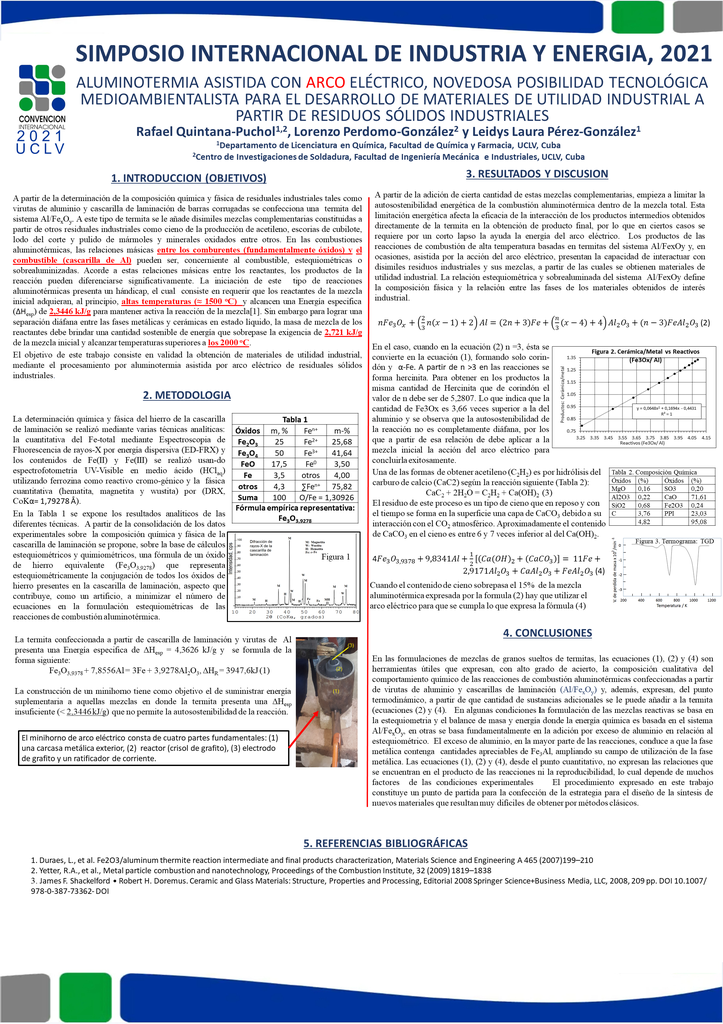Executive Secretary

Simposio Internacional de Industria

Problemática: Se desconoce el alcance del comportamiento de residuales en el desarrollo de materiales de utilidad industrial, procesados por aluminotermia asistida por arco.
Objetivo(s): Validad la obtención de materiales de utilidad industrial, mediante el procesamiento por aluminotermia asistida por arco eléctrico de residuales sólidos industriales.
Metodología: A partir de la composición química y fásica de residuales industriales tales como virutas de aluminio y cascarilla de laminación de barras corrugadas se confecciona un tipo de termita del sistema Al/FexOy. A este tipo de termita se le añade disimiles mezclas complementarias constituidas a partir de otros residuales industriales como cieno de la producción de acetileno, escorias de cubilote, lodo del corte y pulido de mármoles y minerales oxidados entre otros.
Resultados y discusión: A partir de la adición de cierta cantidad de estas mezclas complementarias, empieza a limitar la autosostenibilidad energética de la combustión aluminotérmica dentro de la mezcla total. Esta limitación energética afecta la eficacia de la interacción de los productos intermedios obtenidos directamente de la termita en la obtención de producto final, por lo que en ciertos casos se requiere por un corto lapso la ayuda la energía del arco eléctrico. Los productos de las reacciones de combustión de alta temperatura basadas en termitas del sistema Al/FexOy y, en ocasiones, asistida por la acción del arco eléctrico, presentan la capacidad de interactuar con disimiles residuos industriales y sus mezclas, a partir de las cuales se obtienen materiales de utilidad industrial. La relación estequiométrica y sobre-aluminada del sistema Al/FexOy define la composición fásica y la relación entre las fases de los materiales obtenidos de interés industrial.
Conclusiones: En algunas condiciones la formulación de las mezclas reactivas se basa en la estequiometria y el balance de masa y energía donde la energía química es basada en el sistema Al/FexOy, en otras se basa fundamentalmente en la adición por exceso de aluminio en relación al estequiométrico.
Problem: The extent of the behavior of residuals in the development of industrial utility materials, processed by arc-assisted aluminothermy, is unknown.
Objective (s): Validate the obtaining of materials of industrial utility, by means of processing by aluminothermia assisted by electric arc of industrial solid waste.
Objective (s): Validate the obtaining of materials of industrial utility, by means of the processing by aluminothermia assisted by electric arc of industrial solid waste.
Methodology: A type of thermite of the Al/FexOy system is made from the chemical and phasic composition of industrial waste such as aluminum shavings and mill scale of corrugated bars. To this type of termite is added dissimilar complementary mixtures made from other industrial residues such as sludge from acetylene production, cupola slag, sludge from cutting and polishing marble and oxidized minerals, among others.
Results and discussion: From the addition of a certain amount of these complementary mixtures, it begins to limit the energy self-sustainability of the aluminothermic combustion within the total mixture. This energy limitation affects the efficiency of the interaction of the intermediate products obtained directly from the termite in obtaining the final product, so in certain cases the help of the electric arc energy is required for a short period. The products of the high temperature combustion reactions based on termites of the Al / FexOy system and, on occasions, assisted by the action of the electric arc, have the ability to interact with dissimilar industrial wastes and their mixtures, from which they are They obtain materials of industrial utility. The stoichiometric and over-aluminated relationship of the Al / FexOy system defines the phasic composition and the relationship between the phases of the materials obtained of industrial interest.
Conclusions: In some conditions the formulation of the reactive mixtures is based on stoichiometry and the balance of mass and energy where the chemical energy is based on the Al / FexOy system, in others it is fundamentally based on the addition of excess aluminum in relation to the stoichiometric.
Sobre el ponente

Dr. Rafael Quintana Puchol

Trabajo como profesor en la UCLV

